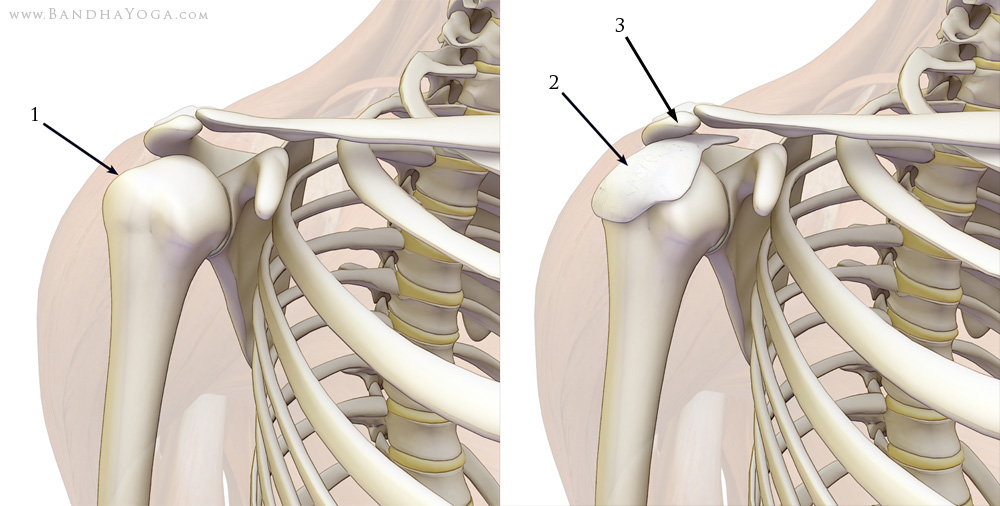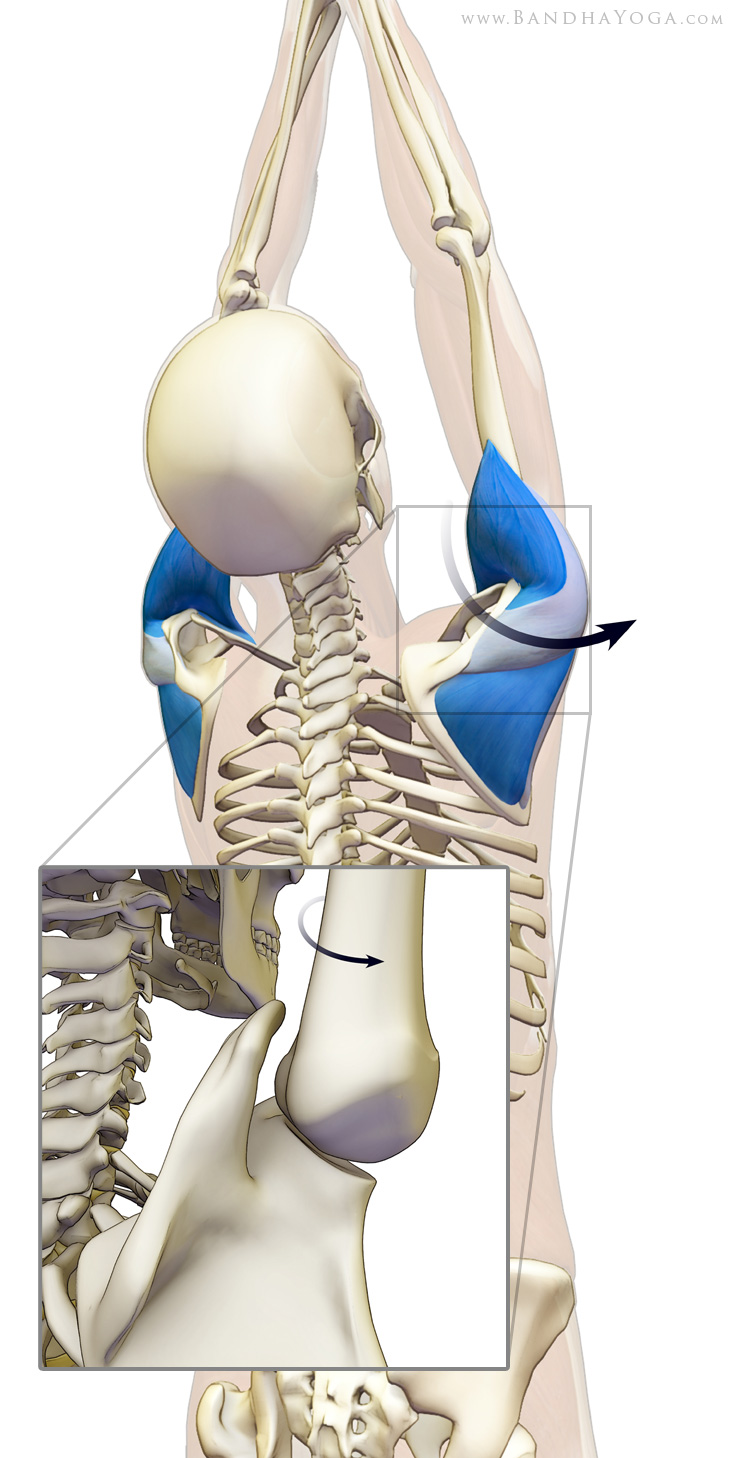The shoulder is the most mobile joint in the body. It is a combination of several articulations: the glenohumeral, scapulothoracic, sternoclavicular, and acromioclavicular joints (click here to see these). Each of these contributes to shoulder and arm movement via a process known as joint “coupling.” For example, when you raise the arms over the head in Urdhva Hastasana, the clavicle pivots on the sternum (breastbone), the scapula rotates on the chest wall, and the head of the humerus moves within the shoulder joint. All of these work together simultaneously in what is known as scapulohumeral rhythm. In general, 60 degrees of this action comes from movement of the shoulder blade on the chest wall (scapulothoracic motion) and 120 degrees from the ball and socket of the shoulder (glenohumeral motion). During this process, the clavicle rotates on its long axis approximately 25 degrees and the humerus externally rotates about 45 degrees. Scapulohumeral rhythm is illustrated in the video below.
So we can see that the shoulder is a complex structure, with many factors contributing to movement, or potentially restricting it. It’s easier to understand a complex structure by breaking it down into its component parts and then reconstructing them into the whole. This gives a new understanding of their function. For the shoulder, we’ll begin by focusing on the skeletal anatomy of the glenohumeral joint.
Now let’s consider how this relates to actual practice. Particularly in Vinyasa, there is a tendency to do the same movement many times, which can lead to repetitive stress injury, such as inflammation of the subacromial bursa and supraspinatus tendon—“rotator cuff syndrome” in the orthopedic nomenclature. You can help to avoid this by engaging the infraspinatus and teres minor muscles and, to a lesser extent, the posterior third of the deltoid. These muscles act to externally rotate the humerus and bring the greater tuberosity away from the undersurface of the acromion. We illustrate this movement here in Urdhva Hastasana. To read about the anatomy and to see this concept in action in Dog Pose and Full Arm Balance, click here.
So we can see that the shoulder is a complex structure, with many factors contributing to movement, or potentially restricting it. It’s easier to understand a complex structure by breaking it down into its component parts and then reconstructing them into the whole. This gives a new understanding of their function. For the shoulder, we’ll begin by focusing on the skeletal anatomy of the glenohumeral joint.
Here’s the Anatomy . . .
The glenohumeral joint comprises the humeral head and the glenoid fossa of the scapula, which together form a shallow ball and socket joint. The proximal humerus also has two protuberances to which the muscles of the rotator cuff attach. These are the greater and lesser tuberosities. To see the anatomy of the rotator cuff, click here.
Another important structure of the scapula is the acromion process. This shelf-like projection of bone forms a roof over the top of the glenohumeral joint. It is also the attachment site for the deltoid and part of the trapezius. The subacromial bursa lies between the acromion and the proximal humerus (the humeral head and the greater tuberosity). It is a sac-like structure that facilitates gliding of the greater tuberosity and tendons of the supraspinatus and infraspinatus muscles on the undersurface of the acromion.
This Brings Us To Subacromial Impingement . . .
When the arm is raised, either to the side or in front of the body, the greater tuberosity can “impinge” on the undersurface of the acromion, compressing the subacromial bursa and irritating the supraspinatus tendon. This is most likely to happen if the humerus is internally rotated. Externally rotating the upper arm bone draws the greater tuberosity out of the way of the acromion and aids to prevent impingement. The acromion comes in several different shapes, ranging from flat to curved, with curved acromions being associated with a greater incidence of subacromial impingement.
 |
| The first image shows impingement of the subacromial bursa with the humerus internally rotated. The second image illustrates external rotation of the humeral head preventing impingement |
So What Does This Have To Do With Yoga . . .
The question has been raised as to whether persons with a curved acromion are limited in their ability to perform certain asanas. For example, the inference that appears to have entered the yogic nomenclature is that if you cannot bring your arms vertical in a pose like Urdhva Dhanurasana, you must have a curved (not a flat) acromion. This is incorrect. First, it is well-established through many studies that a curved acromion does not affect the functional range of motion of a healthy shoulder. People with curved acromions can raise their arms overhead just as far as those with a flat acromion. Second, it is impossible to tell the shape of someone’s acromion process by observing them in a yoga pose. Acromial morphology is something that is determined with a specialized X-ray.
So to answer the question, “In a healthy shoulder, do curved acromions affect the ability to raise your arms overhead in a pose such as Urdhva Dhanurasana?” The answer is no. A curved acromion does not affect range of motion in a healthy shoulder and thus is not the reason why someone cannot bring their arms to vertical in Upward Facing Bow. There are many possible explanations for this limitation, including tightness in various muscles or ligaments about the shoulder, but a curved acromion is not one of them.
How Do We Prevent Impingement?
Thanks for checking in. We’ll see you for the next post when we go over the muscles that move and stabilize the scapula. Be sure to download volume two of our free interactive eBook. Also, don’t forget to tell your friends about our blog and to visit us on Facebook for your free chakra poster.


Комментариев нет:
Отправить комментарий